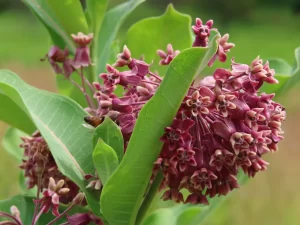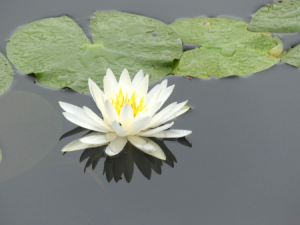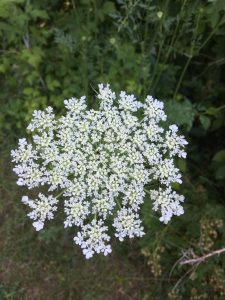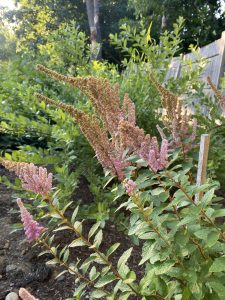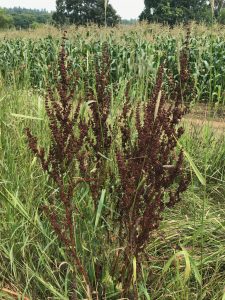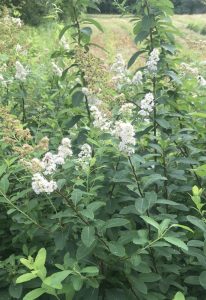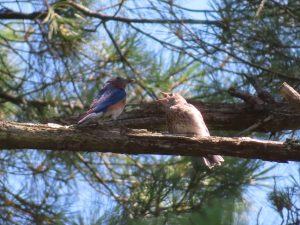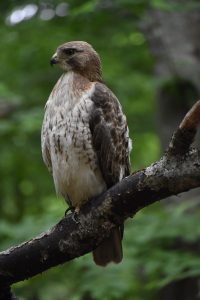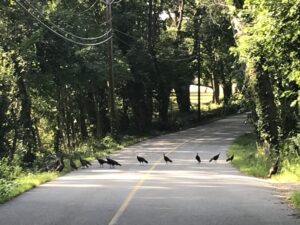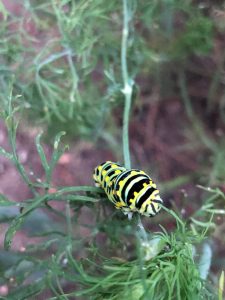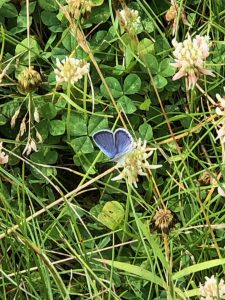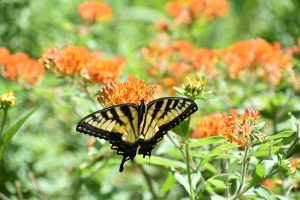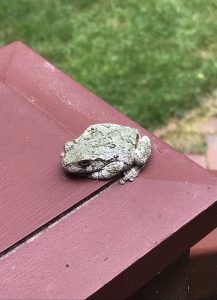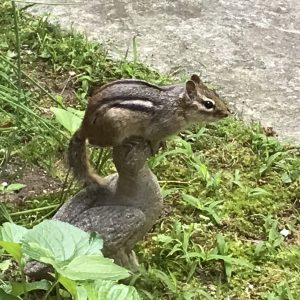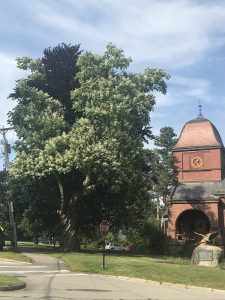Written by Gwyn Loud for the Lincoln Land Conservation Trust. She welcomes your sightings and questions at 781-259-8690 or gwynloud555@gmail.com. This column will resume in September.
We have enjoyed many sunny days over the past month, good for human activities such as picnics, day camps, and swimming. Aerial insectivores such as swallows have also benefited, as dry weather makes it easier for them to catch insects on the wing. As this column goes to press, we are in the midst of a searing multi-day heat wave. At least we are fortunate to have greenery (except for brown lawns) and shade trees all around us. Drought conditions are taking their toll on plant life. To quote the July 8 Landscape Message from UMass, Amherst, “The lack of any substantial and steady rain continues to be a concern for our trees and shrubs. Despite the recent rain, recorded precipitation is well below average levels and this has been the case for the months of March, April, May, and June. Signs of stress are apparent on trees and shrubs with premature leaf drop, leaf discoloration, and flagging.” Ninety percent of the Commonwealth is experiencing drought and Middlesex county is now listed in the Significant Drought category. Streams and ponds are low. The drought is just one example of how climate change is impacting our environment.
Trees are showing the deep greens of midsummer and berries and seeds are forming. Our beloved catalpa tree by the Library put on an elegant display of flowers a few weeks ago. In fields and along roadsides look for flowering Queen Anne’s lace, milkweed, meadowsweet, early goldenrod, and the dark brown seeds of dock on tall spikes punctuating the verge.
Blooming water lilies bring beauty to ponds in shades of yellow, pink, and white. It’s good to see that many homeowners are letting lawns grow longer, allowing clover to flower and thus providing nectar for bees. Many people are planting shrubs and flowers to help various pollinators, including hummingbirds, butterflies, and wild bees.
Bird song has diminished a lot, as always happens in the summer. We can hear fledglings calling, however, and young hawks such as red-tailed hawks are particularly demanding and strident. Certain woodland species such as the Eastern wood-pewee and pine warbler, are continuing to sing and I have been happy to hear a few wood thrushes still singing their musical ee-o-lay notes from the woods. The overall decline in songbirds is noticeable, alas, and from personal experience, each year I hear fewer red-eyed vireos, indigo buntings, scarlet tanagers, and great-crested flycatchers singing in the summer.
Many birds have raised more than one brood, and a few bluebirds even go for a third family. One observer wrote about patiently waiting and watching to see baby bluebirds leave the nest box : “Just before the fledging, the male came to the hole with a sunflower seed and intentionally didn’t give it to the chick and instead flew with it into the nearby maple. Shortly after, the chick followed him. Now another chick face is sticking out… but then went back down onto the nest. It’s amazing how well the first chick could fly even though it had had no practice whatsoever and had hardly observed any other birds fly. This could take all day or even into tomorrow. “ An observer at another location watched newly hatched bluebirds high in the trees being fed honeysuckle berries and blueberries by their parents. I am awaiting the annual sight of young barn swallows lined up and twittering on the wires along Conant Rd. by Browning Field; I like to imagine they are talking about their upcoming migration to Central and South America.
Avian sightings from around town include a willow flycatcher in the wetland south of Baker Bridge Road, a common loon on Flint’s Pond, a green heron flying often over Boyce Field, and red-winged blackbirds starting to gather in flocks rather than small family groups. Bobolinks at Farm Meadow have had at least one successful nest and are now also gathering in flocks, preparing to start their fall migration. The many mute swans on Farrar Pond, none of which raised young, have all left for parts unknown. Wild turkey flocks are in evidence as they feed in fields or march across roads, the flocks consisting of adult hens and their poults, often combining several families.
Butterflies such as tiger and black swallowtails have been dancing from flower to flower in our gardens and many people have spotted monarchs on milkweed. A recent article in the National Geographic states, thanks to a new citizen-science surveying system, that the monarchs may be present in healthier numbers that previously thought, although their wintering grounds in Mexico continue to be threatened by illegal forest clearing. It has been a joy to watch fireflies this summer, blinking their messages from fields, lawns and woods. I have just heard my first cicada of the season and August will bring a rousing insect chorus of grasshoppers, crickets, and katydids. I have seen few earwigs this summer, probably because they like damp conditions and it has been too dry.
Residents have reported seeing our usual mammals such as deer, rabbits, woodchucks, squirrels, and chipmunks; one homeowner watched a chipmunk eating pansy flowers and I know they enjoy taking bites from my ripening tomatoes. Less common recent mammal sightings include a mink in a pond near the Pigeon Hill trails and a bobcat crossing a backyard on Old Sudbury Road. Coyotes give howling nighttime choruses in several parts of town.
As for amphibians, American toads may surprise you as they hop in your lawn or garden; I am always glad to see one as I know it is catching insects with its long sticky tongue. Let’s hope that the young wood frogs which hatched in vernal pools were able to grow all four legs and make it to their summer habitats before the ponds dried up. On a recent evening following showers the gray tree frogs were trilling loudly. Garter snakes and milk snakes have been seen frequently, although, sadly, some had been killed on roads.
Looking skyward, the next major meteor shower will be the Perseids, peaking this year on August 11-12. There will also be a full moon on August 11. To quote the meteor calendar of the American Meteor Society, “The Perseids are active from July 14 to September 1. They reach a strong maximum on August 12 or 13, depending on the year. Normal rates seen from rural locations range from 50-75 shower members per hour at maximum. The Perseids are particles released from comet 109P/Swift-Tuttle during its numerous returns to the inner solar system. They are called Perseids since the radiant (the area of the sky where the meteors seem to originate) is located near the prominent constellation of Perseus the hero when at maximum activity.”
This column will next appear in September. Here’s to a nature-filled August for all readers!
Relevant links:
To read about the drought in MA


